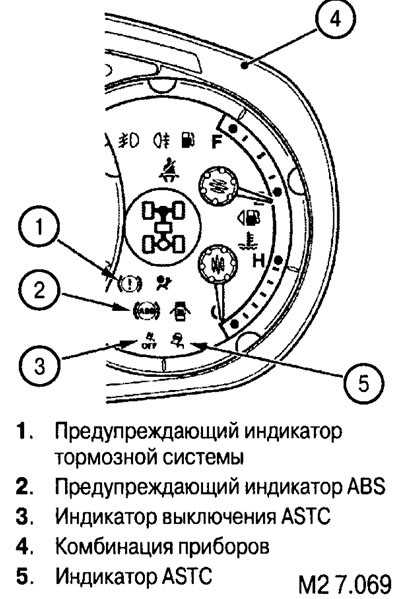Hydro unit
In addition to standard ABS systems, ASTC requires in-line valves (one for each diagonal, two in total) and a pressure sensor.
Stability indicators
The indicators light up and flash in the following cases.
Brake System Warning Indicator:
- lights up for 3 seconds during the test after the ignition is turned on;
- lights up when the ignition is on in the event of a malfunction in the electronic brake force distribution system (EBD);
- flashes 1 time per second if the G/Y sensor or rudder sensor is not set to neutral.
ABS Warning Indicator:
- lights up for 3 seconds during the test after the ignition is turned on;
- in case of forced activation of the actuator;
- lights up when the ignition is on in the event of a malfunction in the ABS system;
- lights up permanently in case of too low power supply voltage of the ASTC-ECU unit;
- flashes 1 time per second if the G/Y sensor or rudder sensor is not set to neutral.
ASTC indicator:
- lights up for 3 seconds during the test after the ignition is turned on;
- in case of forced activation of the actuator;
- flashes 1 time per second if the acceleration and yaw sensor or the rudder sensor is not set to neutral;
- flashes 4 times per second when the ATC or ASC control is turned on.
ASTC off indicator:
- lights up for 3 seconds during the test after the ignition is turned on;
- in case of forced activation of the actuator;
- flashes 1 time per second if the acceleration and yaw sensor or the rudder sensor is not set to neutral;
- burns at - the included ignition in case of malfunction in the ABS system;
- lights up when the ASC is turned off using the switch;
- flashes 2 times per second if the system is shutting down to protect the ASTC-ECU from overheating.

ASTC-ECU unit
The ECU combines the functions of ABS, EBD, ASC and ATC. This makes it possible for ASTC-ECU and ABS to work together and control engine power and braking force in a coordinated manner.
Active Stability Control System (ASTC) adds an acceleration and yaw sensor, a steering wheel sensor, and a master cylinder pressure sensor to the ABS.
The ASTC-ECU unit collects information about the movement of the car from various sensors and creates a model of the ideal movement of the car. After comparing the actual and ideal movement, the unit controls the braking force of each wheel and engine power in order to approximate the actual movement of the car to the ideal model. The block also prevents understeer or oversteer by controlling torque.
